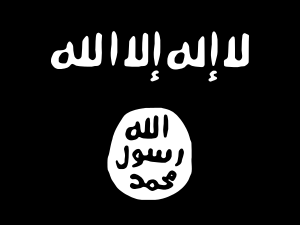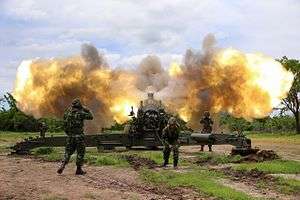M198 howitzer
| M198 Howitzer | |
|---|---|
|
A 155 mm M198 howitzer firing | |
| Type | Towed howitzer |
| Place of origin | United States |
| Service history | |
| In service | 1979 to present |
| Used by | See Operators |
| Wars | Gulf War |
| Production history | |
| Designed | 1968–1977 |
| Manufacturer | Rock Island Arsenal (US) |
| Unit cost | US$ 527,337 |
| Produced | 1978–1992 |
| Number built | 1,600+ |
| Specifications | |
| Weight | 7,154 kg (15,772 lb) |
| Length |
Combat: 11 m (36 ft 2 in) Travel: 12.3 m (40 ft 6 in) |
| Barrel length | 6.09 (19.98 ft)[1] |
| Width | Travel: 2.8 m (9 ft 2 in) |
| Height | Travel: 2.9 m (9 ft 6 in) |
| Crew | 9 enlisted men |
|
| |
| Caliber | 155 mm (6.1 in) |
| Elevation | -5° to +72° |
| Traverse | 45° |
| Rate of fire |
Maximum: 4 rpm Sustained: 2 rpm |
| Muzzle velocity | 684 m/s (2,240 ft/s) |
| Maximum firing range | Conventional: 22.4km (14 mi) RAP: 30km (18.6 mi) |
The M198 howitzer is a medium-sized, towed 155mm artillery piece, developed for service with the United States Army and Marine Corps. It was commissioned to be a replacement for the WWII-era M114 155 mm howitzer. It was designed and prototyped at the Rock Island Arsenal in 1969 with firing tests beginning in 1970 and went into full production there in 1978. It entered service in 1979 and since then 1,600 units have been produced and put into operation.
The M198 is being replaced in US and Australian service by the M777 howitzer.
Description
The M198 155 mm howitzer weighs less than 16,000 pounds (7,300 kg), allowing it to be dropped by parachute or transported by a CH-53E Super Stallion or CH-47 Chinook. The M198 is a towed howitzer that is transported tail first. The gun tube can be rotated over the howitzer's trail legs to reduce its length, though this requires removal of the muzzle brake, or left in the firing position for faster deployment. When firing, the weapon is lowered onto its baseplate rather than being anchored to the ground, allowing for rapid emplacement. The breech is operated manually via a screw type mechanism that rests low in an ergonomic position. The M198 fires non-fixed ammunition and can be loaded with a variety of propellants and projectiles. The effective range is 18,100 meters when firing standard projectiles, which increases to 30,000 meters when firing rocket-assisted projectiles and guided ammunition. With the 52-caliber modification the range can surpass 40,000 meters. The weapon system requires a crew of 9 and is capable of firing at a maximum rate of four rounds per minute, two sustained.
The M198 is deployed in separate corps- and army-level field artillery units, as well as in artillery battalions of light and airborne divisions. It also provides field artillery fire support for all Marine Air-Ground Task Force organizations.
Capable munitions
_001.jpg)
- High Explosive (HE)
- (M-107 NC/DC): Explosive Composition B material packed into a thick, internally scored shell which causes a large blast and sends razor-sharp fragments at extreme velocities (5,000–6,000 meters per second). The kill zone is approximately a radius of 50 meters and casualty radius is 100 meters. The Marine Corps and US Army also uses the M795 High Explosive round.
- Rocket Assisted Projectile (RAP)
- A rocket-assisted HE (also known as H.E.R.A.) M549 round that adds to the maximum range of the normal HE. For the 155 mm RAP round, max range is 30.1 kilometres (18.7 mi).
- White Phosphorus (WP)
- A base-ejecting projectile which can come in two versions: felt-wedge and standard. White phosphorus smoke is used to start fires, burn a target, or to create smoke which is useful in concealing the movements of friendly units.
- Illumination
- Illumination projectiles are base-ejecting rounds which deploy a bright parachute flare ideally 600 meters above the ground and illuminates an area of approximately 1 grid square (1,000,000 square meters). Illumination rounds are often used in conjunction with HE rounds, to illuminate the target area so that HE rounds can be fired more effectively. Illumination rounds can also be used during the daytime to mark targets for aircraft. The M485 Illumination round burns for 120 seconds.
- Dual-Purpose Improved Conventional Munition (DPICM)
- A base-ejecting projectile that drops 88 bomblets above a target. Each bomblet has a shaped-charge munition capable of penetrating two inches of solid steel as well as a fragmentation casing which is effective against infantry in the open. The DPICM round is effective against armored vehicles, even tanks (since the deck armor is usually the thinnest on the vehicle), and is also extremely useful against entrenched infantry in positions with overhead cover.
- Area Denial Artillery Munition System (ADAMS)
- An artillery round that releases anti-personnel mines. These mines eject tripwires to act as booby traps, and when triggered are launched upward before exploding. They are designed to self-destruct after a pre-determined period of time.
- Remote Anti Armor Mine System (RAAMS)
- An artillery round that releases anti-armor mines, usually used along with ADAMS rounds to prevent the antitank mines from being removed. Designed to self-destruct after a pre-determined period of time.
- Copperhead
- An artillery launched guided high-explosive munition used for very precise targeting of high-value targets such as tanks and fortifications. It requires the target be designated with a laser designator system. This round is currently no longer produced or used by the US military.
- Sense and Destroy ARMor (SADARM)
- An experimental munition that is fired in the general direction of an enemy vehicle. The shell activates at a certain point in time ejecting a parachute and then guides itself to the nearest vehicle.
- W48 nuclear shell (retired 1992)
- W48 nuclear artillery shell had a 155mm caliber and an explosive yield of only 72ton, making it one of the smallest nuclear weapons. All units were retired from service in 1992.
Replacement
BAE Systems has won the contract to replace the M198 in the US Army and Marine Corps with its M777 155 mm/39 cal towed howitzer, which weighs less than 4,200 kg (9,300 lb).[2]
Operators
.jpg)
Current operators
-
 Bahrain 18 in service with Royal Bahraini Army
Bahrain 18 in service with Royal Bahraini Army -
 Ecuador: 12
Ecuador: 12 -
 Honduras 12[3]
Honduras 12[3] -
 Iraq 120 howitzers supplied from U.S., 52 of them captured by ISIS
Iraq 120 howitzers supplied from U.S., 52 of them captured by ISIS -
 Lebanon Total is 219 pieces. 36 Howitzers operated by the LAF since the 80's, 41 Howitzers received in 2008, followed by 30 M-198 Howitzers in January, 2010, 72 pieces delivered on 8/2/2015,[4] and a batch of 40 pieces on 8/9/2016 [5]
Lebanon Total is 219 pieces. 36 Howitzers operated by the LAF since the 80's, 41 Howitzers received in 2008, followed by 30 M-198 Howitzers in January, 2010, 72 pieces delivered on 8/2/2015,[4] and a batch of 40 pieces on 8/9/2016 [5] -
 Morocco: 35 units
Morocco: 35 units -
 Pakistan: 148 in service with the Pakistan Army.[6]
Pakistan: 148 in service with the Pakistan Army.[6] -
 Saudi Arabia 42[7]
Saudi Arabia 42[7] -
 Somalia 18 in service with Somali Armed Forces [8]
Somalia 18 in service with Somali Armed Forces [8] -
 Tunisia: 57–60 units in service
Tunisia: 57–60 units in service -
 Thailand: 116 units in service with Royal Thai Army[9]
Thailand: 116 units in service with Royal Thai Army[9]
Other operators
-
 ISIS 52 captured by Islamic State of Iraq and the Levant. Some of them destroyed by air strikes.[10]
ISIS 52 captured by Islamic State of Iraq and the Levant. Some of them destroyed by air strikes.[10]
Former operators
-
 Australia 36
Australia 36 -
 United States 358
United States 358
See also
References
- ↑ Hogg, Ian. Twentieth-Century Artillery. New York: Barnes & Noble Books, 2000. ISBN 0-7607-1994-2 Pg.67
- ↑ U.S. Upgrades and Orders More Lightweight BAE Systems Howitzers, BAE Systems
- ↑ Military of Honduras#Vehicles and Artillery
- ↑ Lebanese Army receives US weapon shipment
- ↑
- ↑ "Pakistan Army". Retrieved 2014-02-04.
- ↑ Saudi Arabian Army#Artillery and Missile Systems
- ↑ Somali Armed Forces#Army equipment.2C 1989
- ↑
- ↑ http://www.businessinsider.com/isis-has-52-american-weapons-that-can-hit-baghdad-2014-7
External links
| Wikimedia Commons has media related to M198 howitzer. |
- Weapon Profile as part of The Whirlwind War The United States Army in Operations DESERT SHIELD and DESERT STORM a publication of the United States Army Center of Military History
- www.fas.org – M198 Towed Howitzer
- www.globalsecurity.org – M198 Towed Howitzer
- www.military.com – M198 155 mm Towed Howitzer
